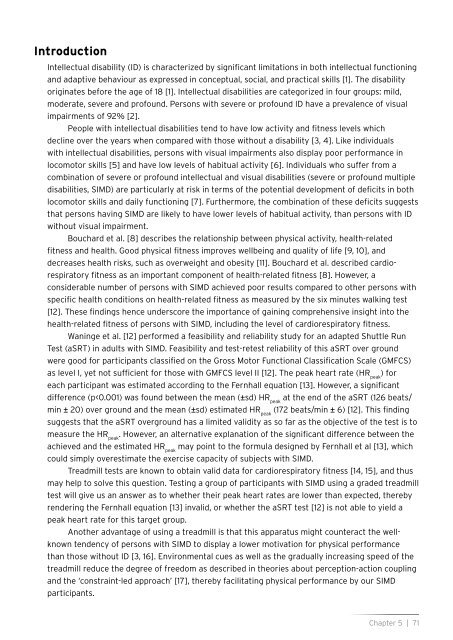Measuring physical fitness in Persons with Severe/Profound ...
Measuring physical fitness in Persons with Severe/Profound ...
Measuring physical fitness in Persons with Severe/Profound ...
- No tags were found...
Create successful ePaper yourself
Turn your PDF publications into a flip-book with our unique Google optimized e-Paper software.
IntroductionIntellectual disability (ID) is characterized by significant limitations <strong>in</strong> both <strong>in</strong>tellectual function<strong>in</strong>gand adaptive behaviour as expressed <strong>in</strong> conceptual, social, and practical skills [1]. The disabilityorig<strong>in</strong>ates before the age of 18 [1]. Intellectual disabilities are categorized <strong>in</strong> four groups: mild,moderate, severe and profound. <strong>Persons</strong> <strong>with</strong> severe or profound ID have a prevalence of visualimpairments of 92% [2].People <strong>with</strong> <strong>in</strong>tellectual disabilities tend to have low activity and <strong>fitness</strong> levels whichdecl<strong>in</strong>e over the years when compared <strong>with</strong> those <strong>with</strong>out a disability [3, 4]. Like <strong>in</strong>dividuals<strong>with</strong> <strong>in</strong>tellectual disabilities, persons <strong>with</strong> visual impairments also display poor performance <strong>in</strong>locomotor skills [5] and have low levels of habitual activity [6]. Individuals who suffer from acomb<strong>in</strong>ation of severe or profound <strong>in</strong>tellectual and visual disabilities (severe or profound multipledisabilities, SIMD) are particularly at risk <strong>in</strong> terms of the potential development of deficits <strong>in</strong> bothlocomotor skills and daily function<strong>in</strong>g [7]. Furthermore, the comb<strong>in</strong>ation of these deficits suggeststhat persons hav<strong>in</strong>g SIMD are likely to have lower levels of habitual activity, than persons <strong>with</strong> ID<strong>with</strong>out visual impairment.Bouchard et al. [8] describes the relationship between <strong>physical</strong> activity, health-related<strong>fitness</strong> and health. Good <strong>physical</strong> <strong>fitness</strong> improves wellbe<strong>in</strong>g and quality of life [9, 10], anddecreases health risks, such as overweight and obesity [11]. Bouchard et al. described cardiorespiratory<strong>fitness</strong> as an important component of health-related <strong>fitness</strong> [8]. However, aconsiderable number of persons <strong>with</strong> SIMD achieved poor results compared to other persons <strong>with</strong>specific health conditions on health-related <strong>fitness</strong> as measured by the six m<strong>in</strong>utes walk<strong>in</strong>g test[12]. These f<strong>in</strong>d<strong>in</strong>gs hence underscore the importance of ga<strong>in</strong><strong>in</strong>g comprehensive <strong>in</strong>sight <strong>in</strong>to thehealth-related <strong>fitness</strong> of persons <strong>with</strong> SIMD, <strong>in</strong>clud<strong>in</strong>g the level of cardiorespiratory <strong>fitness</strong>.Wan<strong>in</strong>ge et al. [12] performed a feasibility and reliability study for an adapted Shuttle RunTest (aSRT) <strong>in</strong> adults <strong>with</strong> SIMD. Feasibility and test-retest reliability of this aSRT over groundwere good for participants classified on the Gross Motor Functional Classification Scale (GMFCS)as level I, yet not sufficient for those <strong>with</strong> GMFCS level II [12]. The peak heart rate (HR peak) foreach participant was estimated accord<strong>in</strong>g to the Fernhall equation [13]. However, a significantdifference (p











